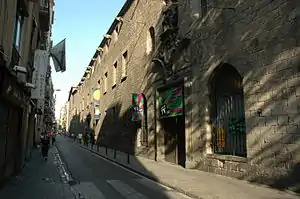El Raval
El Raval (Catalan pronunciation: [əl rəˈβal]) is a neighborhood in the Ciutat Vella district of Barcelona, Catalonia, Spain. The neighborhood, especially the part closest to the old port, was formerly (informally) known as Barri Xinès or Barrio Chino, meaning "Chinatown". El Raval is one of the two historical neighborhoods that border La Rambla, the other being the Barri Gòtic; it contains some 50,000 people.




An area historically infamous for its nightlife and cabarets, as well as prostitution and crime, El Raval has changed significantly in recent years and due to its central location has become a minor attraction of Barcelona. It currently has a very diverse immigrant community (47.4% of its population was born abroad, ranging from all South America, Pakistanis and Filipinos, to a more recent Eastern European community, especially from Romania). It is home to many bars, restaurants, and night spots.
Delimitations
The northern border of the neighborhood is marked by Plaça Catalunya and Plaça Universitat, and the street which connects them, Carrer de Pelai. It ends in the east with La Rambla, and in the west and south, the neighborhood is delimited by Ronda Sant Antoni, Ronda Sant Pau and Avinguda del Paral·lel.
Landmarks
There are a few historical monuments such as the Monastery of Sant Pau del Camp, as well as newer additions such as the Rambla del Raval, and the MACBA (the Contemporary Art Museum of Barcelona) or the Centre de Cultura Contemporània de Barcelona.
In the southern part of the neighborhood an old wall and gate of the medieval city called Portal de Santa Madrona still exists as part of the Maritime Museum. The Raval is also known for its large statue of a cat by Fernando Botero, located on the Rambla del Raval. The city's most famous market, La Boqueria, is also situated in the Raval.
In the eastern part of the neighborhood, Antoni Gaudí's Palau Güell is located on the Carrer Nou de la Rambla.
Cultural depictions
- Josep Maria de Sagarra's 1932 book Vida Privada
- Rafael Gil's 1948 film La calle sin sol
- Jean Genet's 1949 book, The Thief's Journal (Journal du Voleur)
- Joan Colom's photos of the neighborhood in the 1950s
- Eduardo Mendoza's 1975 book La verdad sobre el caso Savolta
- Terenci Moix's 1976 book La caiguda de l'imperi sodomita
- José Antonio de la Loma's 1977 film Las alegres chicas de El Molino
- Ivà's comic strip Makinavaja, started in 1986.
- Francisco Casavella's 1990 book El Triunfo
- Maruja Torres's 1997 book Un calor tan cercano
- Francisco Casavella's 1997 book Un enano español se suicida en Las Vegas
- Roberto Bolaño's 1998 novel The Savage Detectives
- José Luis Guerin's 2001 documentary En construcción
- Carlos Ruiz Zafón's 2001 novel The Shadow of the Wind
- Francisco Casavella's 2002-2003 book trilogy El día del Watusi
- Cesc Gay's 2003 film En la ciudad
- Pau Miró's 2004 play Llueve en Barcelona
- Joaquim Jordà's 2005 film De nens
- Juan Marsé's 2005 book Canciones de amor en Lolita's Club
- Mireia Ros's 2005 film El Triunfo
- Ferran Aisa i Mei Vidal, 2006 book El Raval, un espail al marge
- Antoni Verdaguer's 2006 film Raval, Raval...
- Fernando Gómez's 2008 book El misterio de la Calle Poniente
- Marc Pastor's 2009 book La mala dona
- Francesc Betriu's 2009 documentary Mónica del Raval
- Jo Sol's 2009 film The Runner's Salary
- Javier Calvo's 2009 novel Corona de Flores
- Maruja Torres's 2009 book Esperadme en el cielo
- Alejandro González Iñárritu's 2010 film Biutiful
- Javier Zuloaga's 2011 novel Librería Libertad
- Mathias Énard's 2012 novel Rue des voleurs
- Xavier Artigas and Xapo Ortega's 2014 documentary Ciutat morta
People from Raval
- Enriqueta Martí, serial killer known as the Vampyre of Barcelona.
- Terenci Moix, writer.
- Peret, singer.
- Maruja Torres, writer.
- Manuel Vázquez Montalbán, writer.
- Andreu Jacob, film music composer
See also
- La Paloma
- Raval (Santa Coloma de Gramenet)
- Pakistanis in Spain
